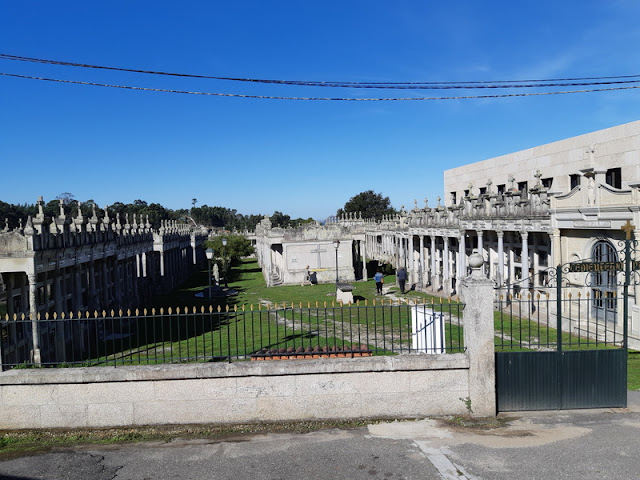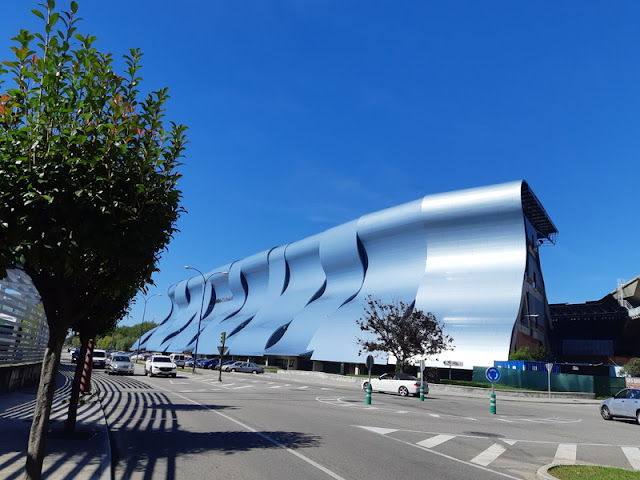Dag 8 Dinsdag 05-10-2021 29 km
Om 06.50 uur begon ik te wandelen, onderweg
nog wat gegeten en gedronken.
Onderweg nog deze kerk bezocht
-
Het stadion in Vigo
Kwam in Vigo de twee Franse dames op een terras tegen
hier wat gegeten en gedronken, besloten samen verder
te lopen erg grote stad Vigo. Gingen bijna weer de mist in, gelukkig werden
we op het juiste spoor gezet moesten door een groot park lopen
Parque de Castrelos, wat we al bijna voorbij liepen.
Hadden 3 uur nodig om door Vigo te komen en mijn Hotel Casablanca te vinden.
Na het inchecken ging ik de buurt verkennen, je weet niet wat je ziet
Vigo is op heuvels gebouwd omhoog gaan soms lopende trottoirs net als op
schiphol, naar beneden moet je lopen.
Mijn Hotel in Vigo
Omhoog hoef je niet te lopen, rollende trottoirs in Vigo
Naar beneden moet je wel lopen
Het winkelcentrum beetje groter als bij ons.
Een klimtoren voor de kinderen

Nog een winkelcentrum bezocht
groot groot en nog eens groot. Om een pleintje met allemaal eettentjes zocht
ik een restaurant op intussen kon je naar een optreden van Dennis Horror
kijken net zo iemand als Youp van het Hek.
Om 21.00 uur weer op de kamer was weer een lange dag.
Baiona naar Vigo veel informatie
Klik op bovenstaande link voor informatie over dit stuk
van de Camino is wel in het Duits.
Op onderstaande link zie je iets over Vigo
Filmpje over Vigo
Iets over Vigo:
We gaan een wandeling van 60 min. maken zie de beschrijving hieronder:
Vigo
is the largest city in Galicia, but it’s possible to discover much of
its past, present and future by taking a one hour walk. This Vigo in 60 minutes tour starts in the centre, where Urzáiz and Príncipe Street meet; there’s a streetlamp, designed by Jenaro de la Fuente in 1932, that is one of the locals’ regular meeting points.
From the streetlamp you’ll see the white silhouette of the MARCO, Museo de Arte Contemporáneo de Vigo (Vigo Museum of Contemporary Art),
a building that was once a jail and courthouse, and now houses the most
modern cultural exhibitions. This is also the entrance to Príncipe Street, the most popular shopping area in the city, which owes its name to Alfonso XII.
By following this pedestrian street to the end we’ll have reached the Porta do Sol (Door
of the Sun). It’s called a door, although there is none, because it was
one of the seven entrances to the ancient walled town. This is where
we’ll find El Sireno,
a sculpture by the Galician artist Leiro Francisco, which represents
the union of Vigo with the sea through a hybrid of a man and a fish, and
one of the city’s symbols.
Straight across the street, we’ll find the Praza da Princesa,
which formerly held the fish market. The fountain called the Angelote
commemorates the reconquest of Vigo, when Napoleon's troops were driven
out in 1809, making it the first Spanish city to rise up against the
invaders. The courage of the people was rewarded with the title of city,
and since then, the Festa da Reconquista is celebrated every 28th of March.
Vigo’s area where you can feel the Reconquista the most is the Old Town, whose streets witnessed the battles. We continue from Praza da Princesa to Praza da Constitución, where you can see the old city hall, now the headquarters of the Casa Galega da Cultura
(Galician House of Culture). Here, we can admire the arcades of the
19th century buildings used by the artisans to sell their products. The
streetlamp in the centre of the square was the first electric light that
was turned on in the city.
If we continue down the left side of the square we’ll find the Rúa dos Cesteiros, a street where you can still find craftsmen’s workshops, and the Praza de Almeida with its Casa de Ceta,
a 15th century house, the oldest in the Old Town and the headquarters
of the Camoes Institute of the Portuguese language. The square honours
Portuguese Lieutenant Almeida, who helped reconquer the city of Vigo.
To the right of this square you’ll find the Church Colegiata de Santa María, which houses the image of the Cristo de la Victoria, whom the victory over the French is popularly attributed to. Just below that you’ll see the Praza da Pedra,
where the people of Vigo met to resolve their disputes in the 16th and
17th centuries. This is where our tour ends; we can browse in the flea
market or finish the route by tasting oysters from the estuary in A Pescadería.
The MARCO opens every day of the year except Mondays and is free of charge.
Ga naar deze link voor meer informatie:
Vigo info






















Geen opmerkingen:
Een reactie posten